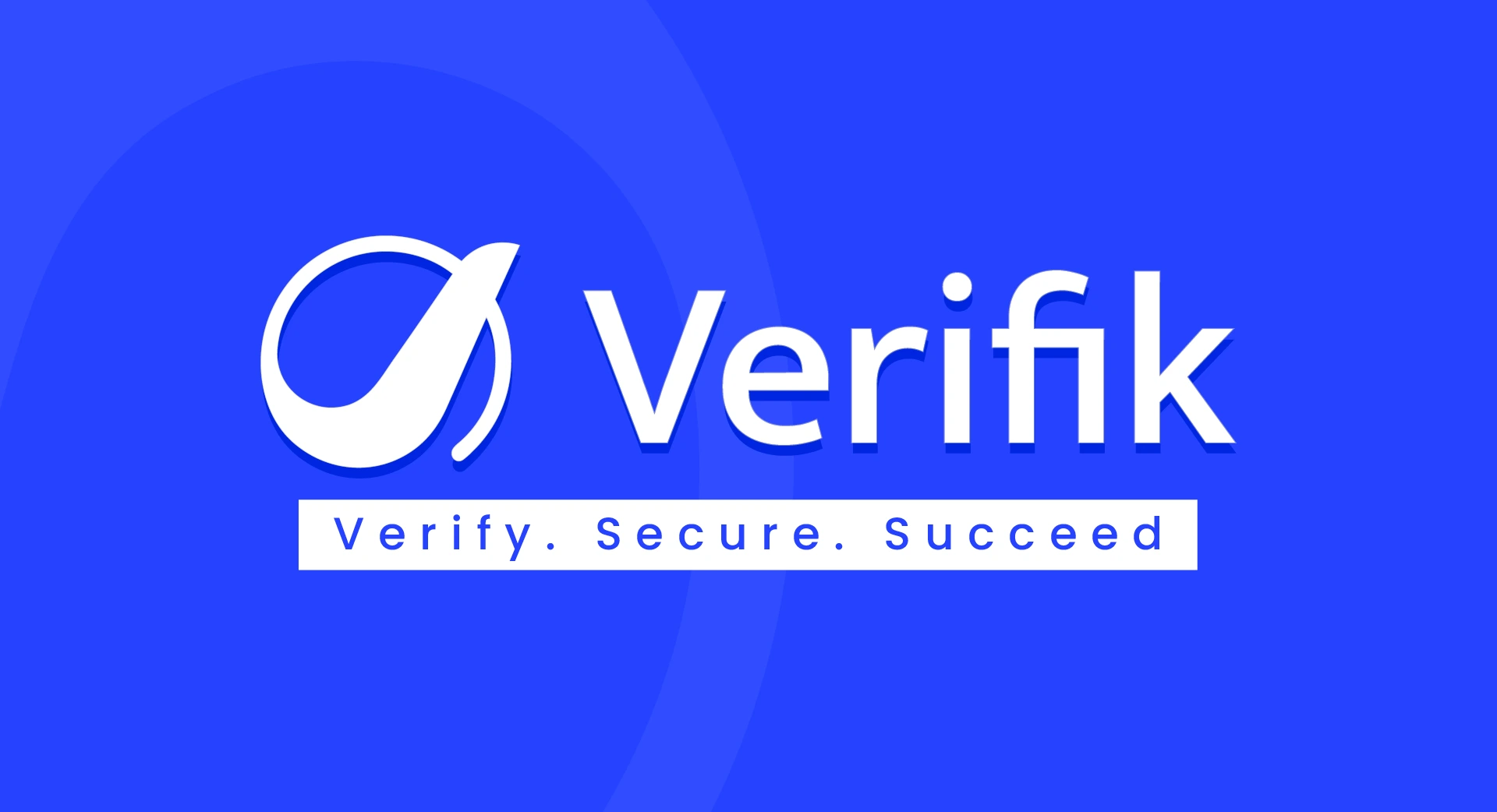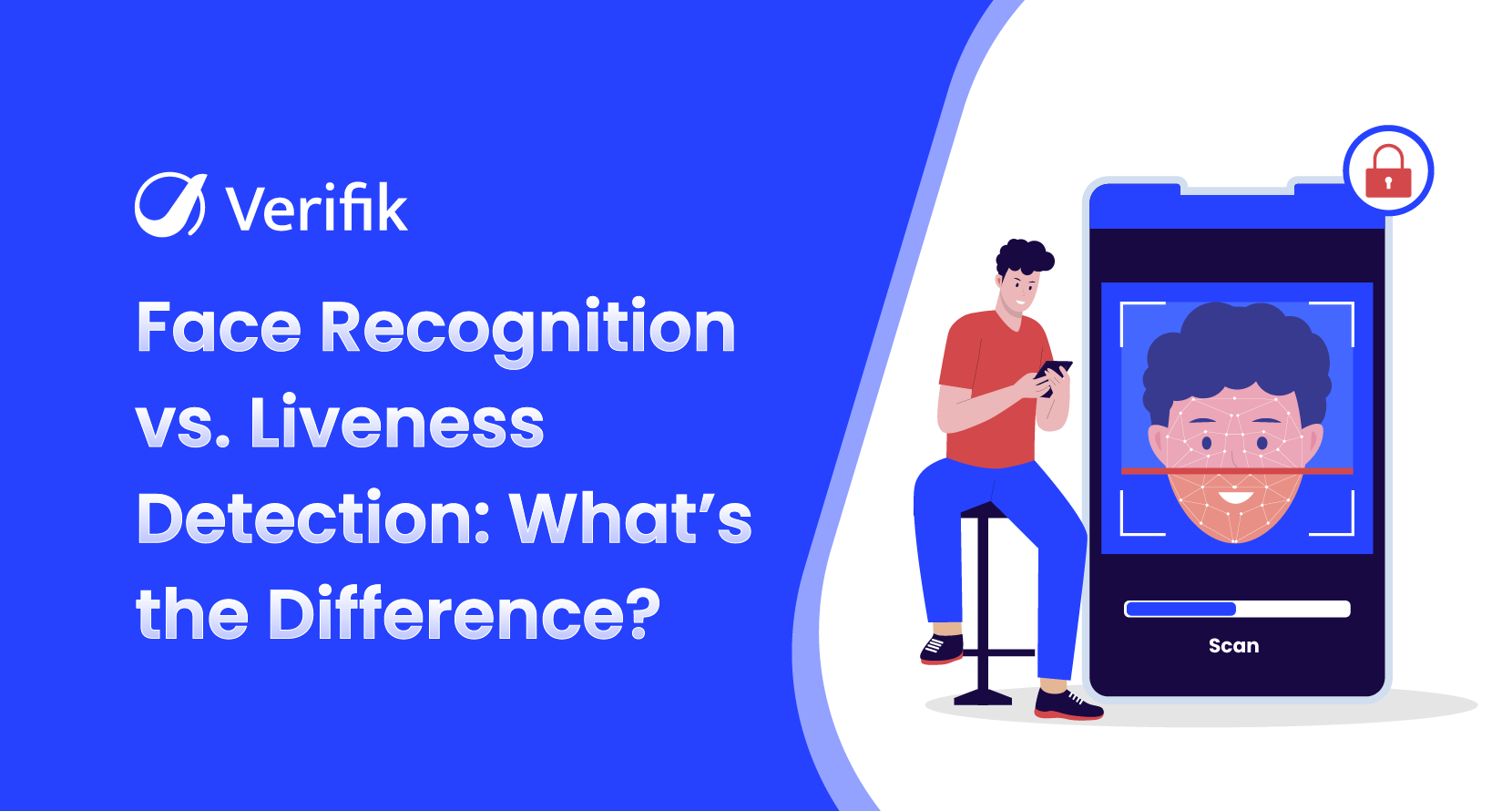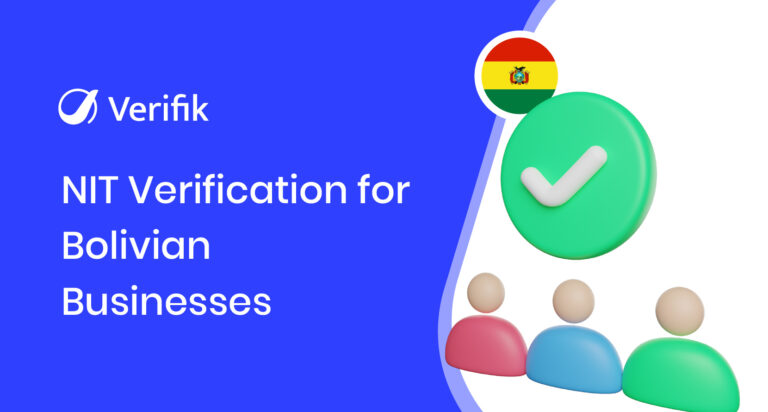Face recognition has quickly become a go-to identity verification method for unlocking devices, signing into apps, and verifying identities online. It’s fast, easy, and feels like something out of the future.
But here’s the thing: when it comes to identity verification, just recognizing a face isn’t enough anymore.
With deepfakes, printed photos, and replay attacks becoming more common, businesses need to do more than just check who is in the picture. They need to know if that person is actually there, in real time.
That’s where liveness detection comes in.
In this blog, we’ll break down what face recognition and liveness detection really do, how they’re different, and why using both is critical if you want to prevent identity fraud without adding friction.
What is Face Recognition?
Face recognition is a biometric technology that identifies or verifies a person based on their facial features. It works by mapping key facial landmarks, such as the distance between eyes, jawline, and nose shape, and comparing them to a stored database of facial data.
Use cases include:
- Unlocking devices (e.g., smartphones)
- Verifying users during onboarding
- Granting access to restricted digital or physical environments
While it’s convenient and fast, face recognition alone doesn’t confirm whether the face is coming from a live person or a static image.
What is Liveness Detection?
Liveness detection is a technology used to determine whether a face presented to a system is from a real and live person, rather than a photo, video, deepfake, or 3D mask. It does this by analyzing movement, texture, blink rate, reflections, and other subtle biological cues that can’t be easily faked.
Liveness detection technology is specifically designed to prevent spoofing attacks, where someone tries to fool the system using a fake identity or stolen photo.
Common applications include:
- Preventing identity fraud
- Securing remote KYC processes
- Ensuring the integrity of facial biometric systems
Two Types of Liveness Detection:
- Active liveness detection: Asks the user to perform an action, like blinking, smiling, or turning their head.
- Passive liveness detection: Works silently in the background using AI to detect texture, motion, light reflection, and other cues without user input.
Why it matters:
Without liveness detection, a face recognition system might accept a printed photo or a deepfake video. That’s a major security risk, especially in industries like banking, gaming, and healthcare.
Key Differences Between Face Recognition and Liveness Detection
Understanding the difference between face recognition and liveness detection is crucial for businesses choosing a robust identity verification solution. Here’s a breakdown of how they differ:
-
Purpose
Face recognition serves as a tool to verify or identify who the user is by analyzing unique facial features. It works by comparing a captured image, usually a selfie or camera snapshot, with a previously stored photo or biometric profile. This process helps determine whether the person attempting access is the authorized user. It’s commonly used in mobile apps, surveillance, and digital onboarding processes to streamline identity verification.
Liveness detection, on the other hand, is designed to verify whether the person in front of the camera is physically present and not a static image or video. Its primary purpose is to ensure that the system isn’t being tricked by spoofing methods such as printed photos or deepfakes. This technology plays a critical role in detecting fraudulent attempts, especially in industries where identity theft is a growing concern.
-
Function
The function of face recognition is simple: it captures a facial image and matches it with one stored in a system’s database. The technology identifies distinct facial characteristics, like the space between the eyes or the structure of the cheekbones, and uses them to either grant or deny access. This function makes it easy to automate user identification across devices and services.
Liveness detection doesn’t rely on matching faces to known records. Instead, it focuses on determining the authenticity of the user by checking for live signs. It identifies movement, depth, and real-time behavior such as blinking or subtle facial shifts to confirm the user is not a spoofed attempt. Its function is especially important in preventing synthetic identity fraud and strengthening the overall identity verification process.
-
Security Level
Face recognition is convenient but has limitations in terms of security. It can be tricked by attackers using high-resolution photos, masks, or video replays. Without any mechanism to confirm if the person is physically present, face recognition can become a target for fraudsters aiming to bypass security with fake visuals.
Liveness detection adds an crucial layer of defense against such threats. It can distinguish between a real, breathing human and a static image or digital fake. By actively or passively detecting life signs, it prevents spoofing and impersonation attempts. For organizations that handle sensitive data or transactions, this added security is critical for maintaining trust and compliance.
-
User Interaction
Face recognition usually requires minimal user interaction. Most systems ask for a selfie or allow users to simply look into the camera, making the experience fast and familiar. This simplicity is a key reason for its widespread adoption across smartphones, apps, and online platforms.
Liveness detection can involve more interaction depending on whether the method is active or passive. Active liveness detection may prompt users to blink, smile, or turn their head, which adds a few extra steps to the process. Passive liveness detection, however, runs silently in the background, requiring no extra effort from the user while still ensuring the session’s security. This allows businesses to maintain low friction without compromising on fraud prevention.
-
Fraud Prevention
While face recognition provides a fast and scalable identity solution, it’s not always effective at stopping fraud. Spoofing techniques, such as using photos, videos, or even 3D masks, can fool facial recognition systems, making them vulnerable to identity theft and account takeovers if used in isolation.
Liveness detection is purpose-built for fraud prevention. It’s designed to catch imposters trying to game the system using synthetic visuals or media. By verifying that the face belongs to a real, living person, liveness detection protects businesses from sophisticated attacks that traditional face recognition might miss.
-
Technology Used
Face recognition technology is based on facial feature mapping, which uses algorithms to extract and analyze key facial characteristics. These are then converted into a biometric signature and matched against a reference image. The technology often uses neural networks, 2D or 3D facial models, and facial embedding to deliver fast and accurate matches.
Liveness detection relies on advanced AI, machine learning, and computer vision techniques. It evaluates motion, texture, depth, and environmental interaction in real-time to differentiate real users from spoofing artifacts. Some systems even assess micro-expressions or how light reflects off human skin, something a flat photo or screen can’t mimic.
-
User Experience
Face recognition offers a smooth and quick user experience. Users can unlock devices or verify their identity in seconds with just a glance at their camera. The speed and ease make it highly suitable for daily logins and large-scale user onboarding.
Liveness detection, especially when passive, can match that same level of smoothness while providing much better protection. Passive liveness checks happen behind the scenes, keeping the process seamless for real users. Even when active methods are used, the extra step adds only a few seconds but significantly boosts the security posture.
-
Compliance Support
Face recognition supports compliance by verifying that a user’s face matches official records, such as a passport or national ID. This satisfies the need for identity confirmation during KYC (Know Your Customer) processes. However, if used alone, it may still allow fake identities to slip through undetected.
Liveness detection plays a crucial role in meeting compliance requirements for KYC, AML (Anti-Money Laundering), and GDPR. It helps businesses prove that not only was an ID checked, but that a real person was present during the verification process. This added assurance is vital for regulated industries such as banking, insurance, and fintech.
-
Use Cases
Face recognition is widely used in applications that require fast identification, such as smartphone unlocking, online account logins, airport security checks, and workplace access msystems. It’s valued for its speed and convenience across both consumer and enterprise platforms.
Liveness detection is critical in high-risk or regulated environments where identity fraud poses a serious threat. Use cases include remote customer onboarding, high-value transactions, and secure digital services in banking, healthcare, and cryptocurrency exchanges. It helps businesses reduce fraud losses while building user trust.
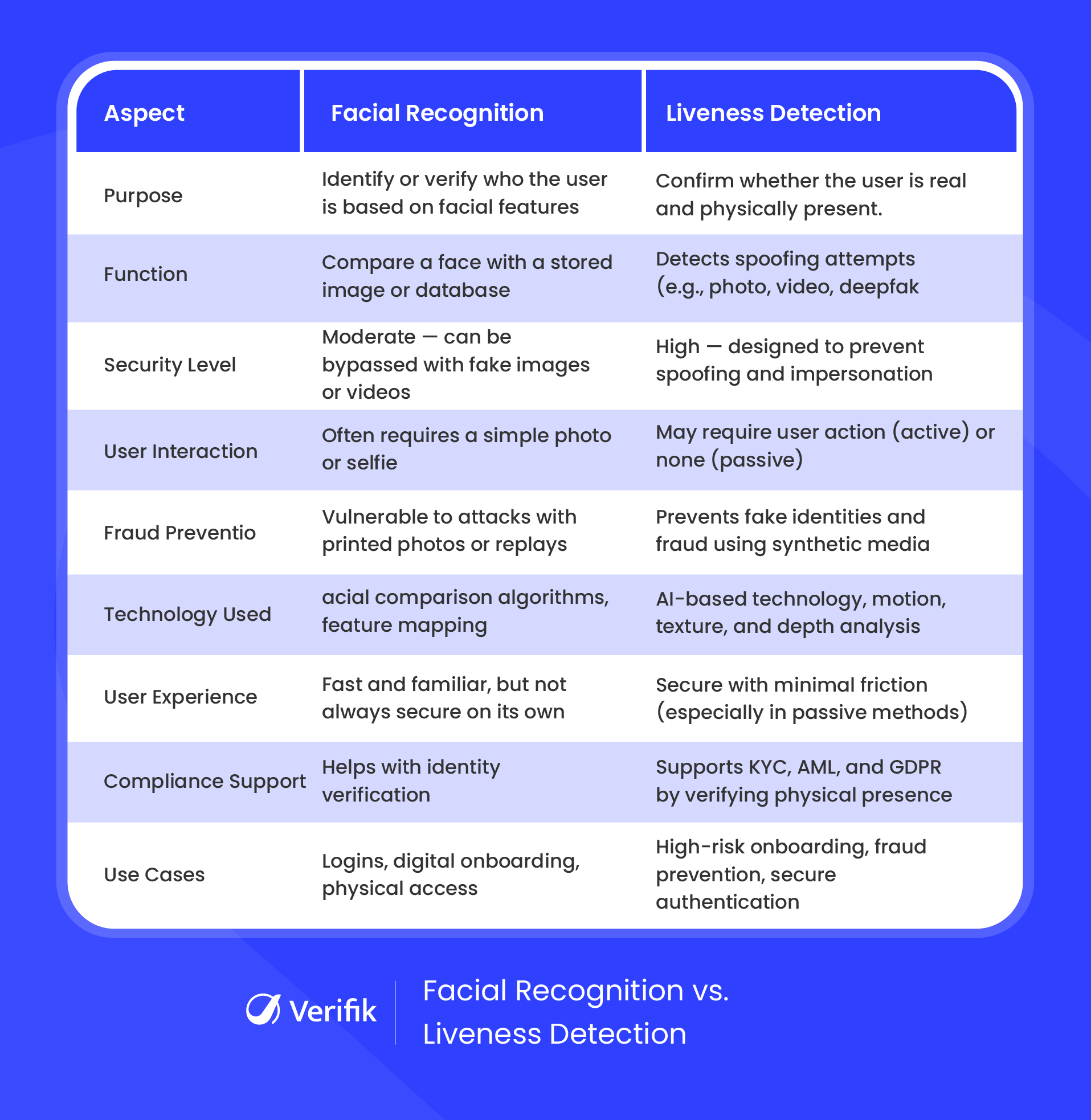
Why Businesses Should Combine Face Recognition with Liveness Detection
Here are a few key reasons why businesses should opt for an identity verification solution that combines both face recognition and liveness detection.
1. Closing the Gaps in Face Recognition
Face recognition is fast and widely used but it’s not perfect. If someone uses a high-quality photo, a video, or even a 3D mask, they can sometimes trick basic facial recognition systems. That’s a serious problem when you’re verifying identities online, especially in industries where trust and compliance are non-negotiable.
This is where liveness detection comes in. It adds an extra layer of defense by checking whether the person in front of the camera is actually there in real time. It helps stop common tricks like replay attacks and deepfakes, things that are becoming easier to pull off every day.
2. Making Identity Checks More Secure
When face recognition and liveness detection work together, the result is a much more secure verification process. First, the system checks if the face matches the one on file. Then, it quietly runs checks in the background to make sure it’s not a still image, a pre-recorded video, or a synthetic face.
This two-step approach significantly lowers the risk of letting in someone who isn’t who they claim to be. For businesses, that means fewer cases of identity fraud, account takeovers, and compliance headaches.
3. Security Without the Hassle
Stronger security doesn’t have to mean a clunky experience for your users. In fact, combining face recognition with passive liveness detection makes things smoother. Users don’t have to blink, turn their heads, or follow complicated prompts, they just take a selfie, and the system does the rest in real time.
This makes the process feel quick and natural, which helps reduce drop-offs during onboarding or login. You get better fraud protection, and your users get an experience that doesn’t feel like a chore.
4. Meeting Compliance Standards with Confidence
In many sectors, verifying identity isn’t just about security, it’s about staying compliant. Regulations like KYC, AML, and GDPR require businesses to verify both identity and presence. Face recognition alone might confirm the face, but not the person behind it.
By adding liveness detection, businesses can confidently prove that a real, consenting person completed the verification process. That’s a key requirement in most compliance frameworks and a smart move to avoid costly penalties or legal exposure.
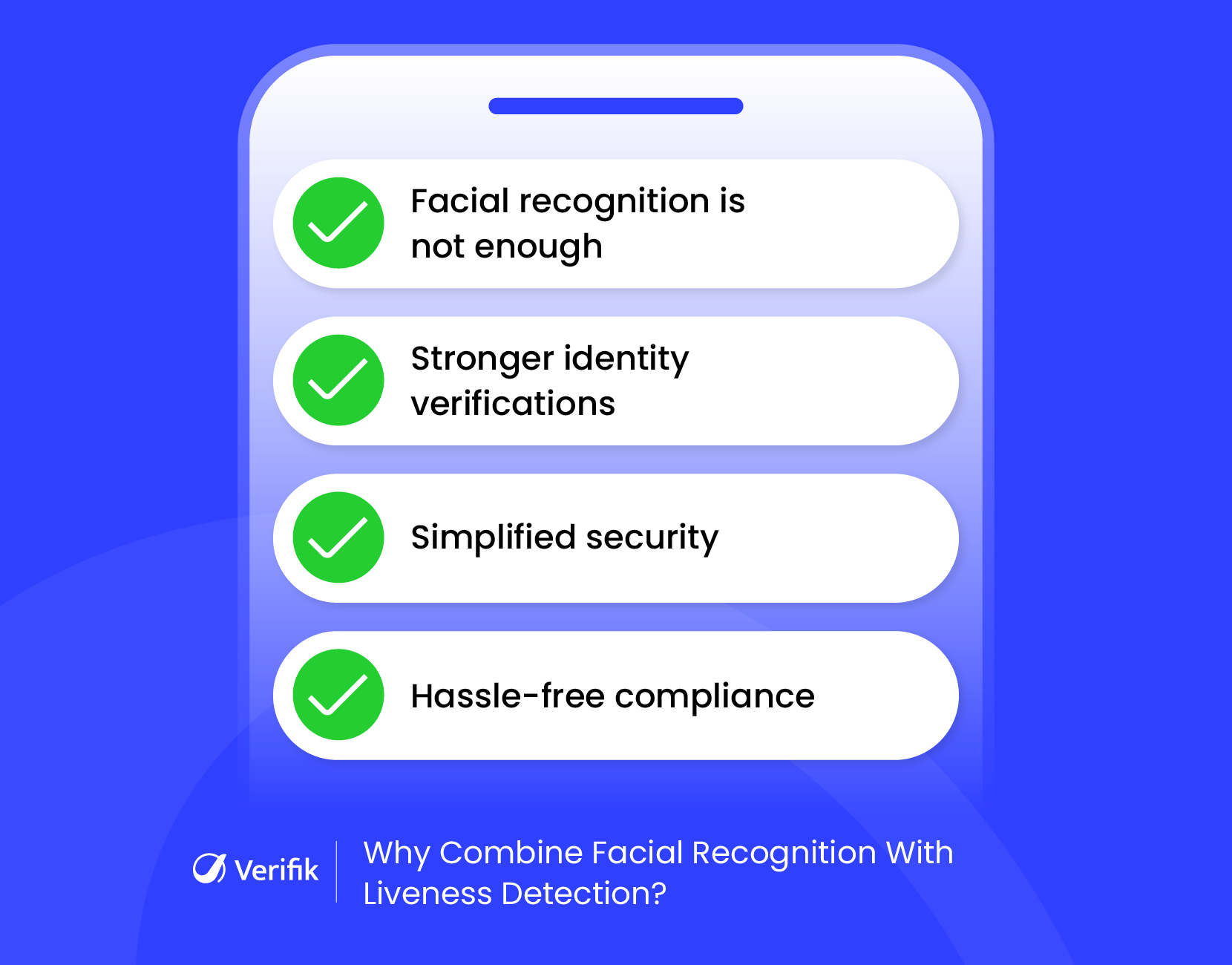
Choosing the Best Identity Verification Solution for Your Business
Selecting between face recognition and liveness detection, or deciding how to combine them, depends on your goals.
Ask yourself:
- Is secure verification of identities your top priority?
- Are you at risk of spoofing or deepfake attacks?
- Do you operate in a regulated industry like finance or healthcare?
Modern identity verification solutions like Verifik’s ZK Face Proof offer the best of both worlds: real-time face recognition with built-in liveness detection, zero biometric storage, and full compliance with global privacy standards.
Final Thoughts
Face recognition and liveness detection serve different but complementary purposes in identity verification. While face recognition ensures accurate identification, liveness detection makes sure that identity is real and live. Relying on one without the other leaves room for fraud. Together, they offer unmatched security, speed, and trust.
Looking to safeguard your business with advanced identity verification? Discover how Verifik, a leading identity verification platform, offers cutting-edge solutions to help you achieve secure, compliant, and seamless verification. Get in touch with us today to find out more!
